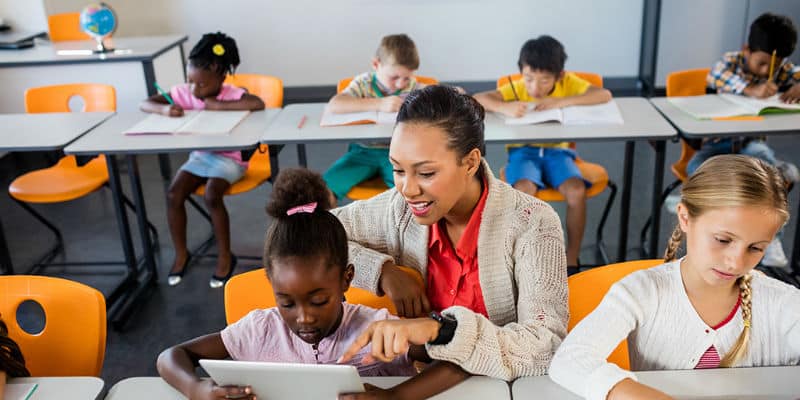What does it take to be a great teacher in a blended program? To ask that same question in education parlance, what competencies—meaning motives, traits, self-concepts, values, knowledge, and skills—matter most for teachers who are substituting online learning for part of face-to-face instruction?
Online and blended learning are relatively new. The precise list of competencies that matter and their relative weights are unknown. Furthermore, given the broad variety of classrooms and students, we’ll never fully untangle which competencies matter most in each circumstance.
But patterns are starting to emerge. Several teams of researchers have tackled the question, and the following are three observations that start to point the way toward answers:
Observation #1: “Mindset competencies” are a critical, sometimes the most important, type of competency for blended teachers.
What are mindset competencies? An iNACOL paper explains: “Mindset competencies include the core values or beliefs that guide an individual’s thinking, behaviors, and actions, and that align with goals of educational change and mission.”
Ready to Blend conducted a large online survey and four small focus groups to discover which competencies educators who are implementing blended programs find to be most important. In each one of these data sets, the top responses included a lot of mindset-type competencies.
Specifically, four mindset competencies scored in the upper bounds: modeling a growth mindset; having an entrepreneurial, creative mindset; having a collaborative, teamwork mindset; and an openness-to-change mindset.
Above all, respondents said that the most important attribute for success is a mental shift from teacher-led to student-centered learning. Jill Gurtner, principal of 21st Century eSchool in Middleton, Wisc., said, “After several years of trying to move this work [of implementing online and blended learning], I’ve found that systems really, really underestimate this one.” She said that getting adults to buy-in and shift their thinking to student-centered learning is the hardest part, and also the most overlooked.
Interestingly, a team of researchers who independently studied the same question (“Which competencies matter most for blended-learning teachers?) arrived at a parallel conclusion. Allison Powell, Beth Rabbitt, and Kathryn Kennedy, who authored the iNACOL Blended Learning Teacher Competency Framework, identified “mindsets” as the first of four clusters of competencies that are important. “Competency 1 Standard 1 for blended teachers,” according to the iNACOL report, is a mindset that reflects a “shift from teacher-led instruction to student-centered learning for the purposes of meeting individual needs and fostering engagement and motivation.”[1]
Observation #2: “Role of the Teacher” competencies are also important, and a surprising number of them are the same as for traditional teachers.
Ready to Blend’s survey and focus group respondents identified a cluster of competencies that relate to the role of the teacher in a blended environment. They prioritized the following competencies:
- Nurture agency and gradually release control. Encourage students to be independent and self-directed learners.
- Encourage teaming. Help students work in cooperative groups.
- Create flexible groupings. Use data to inform and adjust individual instruction and groupings.
- Be a great coach. Provide individualized remediation and feedback. Build relationships of trust.
- Help students hold themselves accountable, set goals, and track their own progress.
The interesting discovery for this cluster of competencies is how well they match distinguished teaching in non-blended settings. In other words, competent blended teachers share many attributes of distinguished traditional teachers.
What does “distinguished traditional teaching” mean? One way to define it is to look to the Danielson Framework for Teaching, the most widely used definition of teaching in the United States. Danielson ranks teacher ability into four levels: unsatisfactory, basic, proficient, and distinguished.
Specifically, the Danielson Framework for Teaching states that in the classrooms of the most distinguished teachers, observers can see that:
- Activities permit student choice.
- Students take initiative in improving the quality of their work.
- With minimal prompting by the teacher, students ensure that their time is used productively.
- Students respectfully intervene with classmates at appropriate moments to ensure compliance with standards of conduct.
- The teacher demonstrates knowledge and caring about individual students’ lives beyond the class and school.
- The teacher respects and encourages students’ efforts.
- The teacher encourages his students to set their own goals.
- High-quality feedback comes from many sources, including students; it is specific and focused on improvement.
This list looks a lot like the bullet-point list right above it! The implication is that quality online learning does not devalue the role of the teacher. Rather, it demands that teachers refocus their work on a cluster of abilities that define some of the most distinguished attributes of traditional teachers.
Observation #3: Blended teaching requires some competencies that are wildly different from traditional teaching.
The two other clusters of competencies that stood out from the Ready to Blend study related to (1) systems and structures, and (2) learning design. We found that in these categories, the highest ranked competencies are nowhere to be found on the Danielson Framework; rather, they are uncharted territory.
Among these next-generation competencies were abilities such as the following:
- Understand and manage the face-to-face and online components of lesson planning and organization within a course. Curate a playlist of relevant, rigorous, and engaging online content or select appropriate prepackaged content.
- Create a daily and weekly schedule for an online or blended course or subject, customizing it for a Station Rotation, Lab Rotation, Flipped Classroom, Individual Rotation, Flex, A La Carte, Enriched Virtual, or Fully Virtual model.
- Counsel students prior to enrollment in a fully online course to assess independence, mentor support, and readiness.
Moving forward
Identifying the competencies that help blended teachers be their best deserves significant effort in the years ahead. One risk to avoid is assuming that any of us knows for sure. The best way to use online learning for education has not been invented yet, so it’s important to be humble about codifying any system.
Another risk is to assume that all blended programs require the same teacher competencies. Drive five miles from KIPP Austin, where Station Rotations are underway, up the street to Acton Academy, which has three Flex studios serving mixed-aged learners, and any notion that teaching looks the same in every blended setting quickly falls apart. Each teacher competency that researchers propose should be pressure checked against anomalies and exceptions.
Those caveats aside, I believe that charting the map for teachers to grow from traditional mindsets, habits, and skills into those of distinguished online and blended teachers is critical. Early patterns in this work reveal a few emerging truths that help point the way.
Heather Staker is the founder and president of Ready to Blend and an alumna of the Christensen Institute. She is the co-author of Blended: Using Disruptive Innovation to Improve Schools and The Blended Workbook, and the author of How to Create Higher Performing, Happier Classroom in Seven Moves: A Playbook for Teachers. Follow her at @hstaker @r2blend.
[1] Separately, three different researchers who studied best practices in top-ranked workplaces outside education (such as Facebook, LinkedIn, Medallia, and so on) came to the same conclusion about the preeminence of mindset development. The report that resulted from their research, which I wrote for them, claims that a large number of top-ranked workplaces obsess about cultivating employee mindsets. They hire for them. They gear their onboarding around them. Facebook posts reminders about mindsets on the walls (“Move fast! Break things! Done is better than perfect!”). Medallia recognizes managers who model growth mindset (“I messed up. Here’s how I’m going to fix it.”). Google goes to lengths to cultivate Googlers’ creativity and passion.



